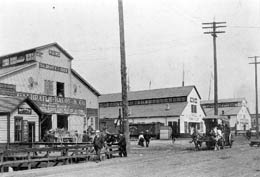Piers 54, 55, and 56 are home to today's Ivar's Acres of Clams restaurant and the renowned Ye Olde Curiosity Shop. The Northern Pacific Railroad built the piers during the golden age of Seattle's maritime commerce spurred by the Klondike gold rush and expanding Pacific trade. The old piers had become obsolete for ocean shipping by the end of World War II, but they found a second life as homes for restaurants, import stores, harbor tours, and (briefly) Namu and other captive killer whales (orcas).
Watch That Wobble
Pier 55 (then called Pier 4) collapsed at 9:30 a.m. on September 14, 1901, less than a year after it was built. It took 2,000 tons of freight with it, but no lives, for the dock master was just able to scamper to the sidewalk when he felt the pier wobble before its fall. The Northern Pacific quickly rebuilt the wharf, with more lateral support this time.
President Theodore Roosevelt disembarked at Pier 56 during his May 23, 1903, visit to Seattle. He was the third president to visit the city. He arrived on the steamship Spokane, escorted by four revenue cutters in full dress and 60 additional boats in columns of four. He was greeted by one of the largest crowds ever to assemble in Seattle. He took a carriage to the University of Washington (located downtown on University Street at the location of the present-day Olympic Hotel) and spoke to an audience of 50,000.
Ye Olde Curiosity Shop
Ye Old Curiosity Shop, started by J. E. Standley in 1899 (and located at farther-south piers in earlier years) quickly became a famous stop for tourists, a market for traditional and newly made Indian artifacts such as totems and baskets, and also a purveyor of non-Indian toys, miniatures, and curiosities. Standley and his shop received visitors from all over the world.
He also exerted an odd but profound influence on Northwest Indian culture, in that local craftspeople sometimes produced items for his store that were based on anthropologists’ descriptions of artifacts from other native cultures.
The New Era: Food and Fun
By the end of World War II, the old piers had become obsolete for ocean shipping, but they found a second life as homes for restaurants such as Ivar's Acres of Clams, import stores, and harbor tours.
In the early 1960s, home-heating-oil magnate Ted Griffin established his Seattle Marine Aquarium on the end of Pier 56. His capture and display of killer whales (oras), beginning with the famous Namu in 1965, drew both visitors and protesters.
To go to Part 6, click "Next Feature"

